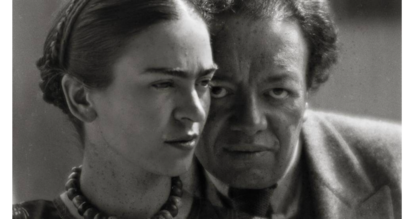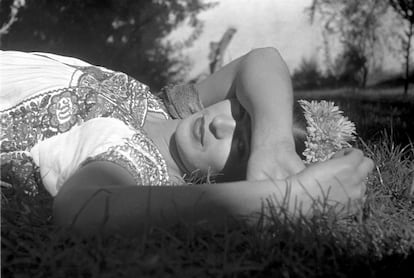Director Carla Gutiérrez admits that for decades she was obsessed with the figure of the painter Frida Kahlo. She lived and grew up with her story; and like millions of people she felt very close to her art. Gutiérrez, originally from Peru, but who has lived in the United States for years, felt challenged by the Mexican’s work at the age of 19, when she was able to see the painting. Self-portrait on the border between Mexico and the United Stateswho, as a newcomer from Latin America, saw herself reflected in that work, missing her homeland “desperately” and “navigating” a new world.
He immersed himself in the writings that Frida had left in her diary, numerous letters, essays and interviews that appeared in printed media of the time. It was through those writings available and accessible to the public that she realized that there were enough fragments of her voice in her words for her to tell her story. “There are hundreds of documents, writings that she left us. They are a really very rich testimony with emotional reactions to what was happening to him then. The documentary does not include all the details of her life, but we wanted, rather, for the public to know, more than anything, her spirit,” he explains. Gutierrez through a video call.
This is how the genesis of Fridaa documentary that took around a year and a half to complete—which was awarded the best edition at the last Sundance Festival—and which intimately and openly narrates some topics that worried the renowned painter, such as the transcendence of her art, her relationship with Mexico, with her husband Diego Rivera, her desire to be a mother, sexual pleasure and the bodily pain that followed her all her life, due to the aftermath of a train accident in her youth.
“The exhibition will open in the Pierre Cole gallery, which I am told is one of the best here (Paris). There was a lot of race on the day of opening. Big congratulations from Joan Miró. High praise for Kandinsky and congratulations for Picasso and other great shits of surrealism, but these rich bastards don’t want to buy anything. I do not have the honor of belonging to the elite of famous artists. Men are kings. “They are the ones who run the world,” actress Fernanda Echevarría, who voices Frida in the documentary, is heard in a fragment about the Mexican artist’s exhaustion with surrealism following a visit she made to the capital. of France, organized by the writer and poet André Breton.
Like the previous example, Gutiérrez puts together a series of thematic columns in the documentary, which reflect on how frustrated Frida was with her physical problems, or her search for pleasure and how she felt oppressed as a woman of that time. How she spoke “in a very beautiful way” with her lovers about her sex or how, in counterpoint, she made her fragility noticeable when she wrote in another text about the spontaneous abortion she had. His reaction to the United States while accompanying Diego Rivera on his commissions for Edsel Ford and the Rockefeller family in Detroit and New York, respectively, or how the colors evoked his moods, from the love he felt for Mexico to the sad moments of his life.

“She spoke very loudly in her writings and we had to listen to her. For us it was important that she guide us in that emotional part. We felt like we gave her her microphone and she didn’t want to let it go,” explains the director.
The review and compilation process for the documentary, first premiered at the Sundance CDMX Festival and now available in theaters throughout the Republic, included a “raid”, with authorization – he clarifies – to the attic of Hayden Herrera, art historian and biographer, whose work on Kahlo was the basis for much of the academic work on the artist since the 1980s. In Herrera’s home they found the original research she had done for her book Frida: a biography of Frida Kahlo (1983), material that also served for the film adaptation that had Salma Hayek as the protagonist, and that had remained stored for more than four decades.
“This research helped us uncover all the primary sources for Frida’s writings and gave us an even more complete understanding of her life. We also found transcripts of complete interviews with people very close to us. Some of these voices are in our film,” adds the director.
But the documentary, available on Prime Video in other Latin American countries, not only sought to revive Frida’s voice through her writings, but also giving life to her images, postcards from the time and even some of her most representative paintings. as The two Fridas (1939), Diego and me (1949) and Henry Ford Hospital (1932), to mention a few. Gutiérrez and his team made a “risky” decision and adapted an animation process that accompanies the film footage in different sections. From giving color to certain black and white photos to making Frida’s paintings come to life as the story is told, a work carried out by designers Sofía Cáceres and Renata Galindo, along with a soundtrack created especially for the film by the Michoacan composer Víctor Hernández Stumpfhauser.

“How can one dare to touch Frida’s art? For me it was important to bring it into a cinematic space. She wanted the art to come to life within a narrative and to be able to guide the audience’s eyes to specific emotional content in her paintings, to create a connection between them and the lived experiences that had inspired these creations. With the explosion of color in her paintings I felt it like an opportunity. They were like another narrative voice,” he says.
The documentary by Gutiérrez, an experienced editor and debut filmmaker, touches on the success and myth of Frida who, like an oracle, brazenly and irreverently predicted the recognition she would receive after her death in 1954. “I think that after my death I will to be the biggest piece of poop in the world,” the painter stated in one of the letters cited in the film.
Insecure, happy, sad, doubtful, jealous, far from the symbol and pop icon that everyone has of her, this is how Frida is portrayed, listened to and conceptualized, “from the fragility of herself, more human. As if you were sitting in front of a person and this was your friend who was telling you their secrets,” concludes the director.
to the EL PAÍS Mexico newsletter and to whatsapp channel and receive all the key information on current events in this country.
_




